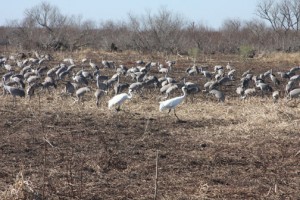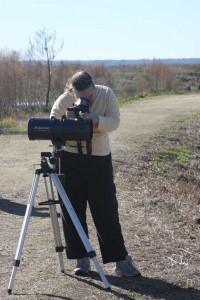The air is alive with noise. All around us on Paynes Prairie near Gainesville it sounds like a thousand squeaky doors swinging open and shut on their hinges – creak, creak, creak.
Noise surrounds us. We can’t see the noisemakers but I can almost taste my anticipation. I really want to see the noisemakers and so does everyone else in the group.
Binoculars swing from neck straps. Cameras are hand held but loosely, at our sides, it isn’t picture time yet. We’re walking along a dike called La Chua Trail, a group of day trippers led by Lars Andersen of Adventure Outpost in High Springs and the author of “Paynes Prairie: A History of the Great Savanna.”
Lars tells us about the Indians who lived here ever so long ago. One tribe controlled Paynes Prairie and its riches including churt, also called flint, a material considered prime for making tools and weapons. Surprise! They were early entrepreneurs with a corner on the market.
A bald eagle flies overhead. We take that as a good sign. The morning is warming up but no one sheds fleece jackets, still too nippy for that. We walk on. The noises are getting louder.
Sandhill cranes flock to Paynes Prairie near Gainesville in the winter months
Suddenly, the scene opens up, the vegetation along the edges of the dike clears and there they are – hundreds of Northern Sandhill Cranes along with two whooping cranes who seem quite comfortable hanging out with sandhills. We’re seeing hundreds around the prairie there are thousands. They are literally snowbirds.
We’re stunned at the sight. It took me a few minutes of staring open-mouthed before I thought, oh, right, camera, raise camera, turn it on, and take pictures NOW. And wouldn’t it be nice to have a longer lens?
Sandhills obviously like to eat and talk simultaneously. These are long lanky birds dressed in grey with red on the tops of their heads. Their beaks push around the prairie mud looking for food. Little spats flare up here and there about who should be where – two cranes lift necks, flap wings at each other, do a little dance, then settle down again to the business of eating plant and animal materials.
In the winter sandhills migrate from Michigan and Wisconsin to South Georgia and Florida. This is a banner year for sandhills at Paynes Prairie. Why so many? No one has THE answer but lots of speculation.
Lars tells us the birds are eating amaranth seeds. Amaranth is an ancient grain, the first to be cultivated as a crop in the New World. Aztecs used amaranth extensively, even in their sacrifice ceremonies.
When the Spanish came along, all things Aztec were forbidden, including growing amaranth. It is making a comeback these days. The grain grows wild on the prairie. This has been a very good year for amaranth; perhaps the sandhill cranes know that and have come to harvest the good stuff. Some sandhills like Paynes Prairie so much they will stay year round but most go back up North.
We meander to the end of the trail and an observation tower. Way off to the left, in a small body of water, a bison is spotted. Bison? Yes, the prairie has them. On the way back we see several alligators and a bittern. It is a banner day for wildlife sightings.
Sandhill Cranes easy to see on LaChua Trail
For Libby Schecher, every visit to Paynes Prairie is special. Libby is from Maine, staying in Gainesville for one year to study acupuncture. “I love coming to the prairie. I’ve fallen in love with alligators, they are so ancient, with small brains but they care for their young, make nests.”
Ah, alligators. One thing I like about walking on dikes is when we see an alligator; it is down in the water, much lower than we are. That works for me. I do not want to look an alligator in the eye. That small brain thinks everything is lunch.
Libby recalls coming to the prairie last week and seeing alligators sunning themselves at Alachua Sink. Along come several wild turkeys that stop, look towards the alligators, discuss the situation, go forward two steps, go backwards two steps, and finally retreat, leaving the area. Smart turkeys.
Paynes Prairie is a 21,000 -acre preserve with multiple access points. The LaChua Trail that we took is three miles round-trip from the North Rim of the Prairie to the observation tower. Main access is 4801 Camp Ranch Road. LaChua Trail opens at 8:00 a.m. and is open 7 days a week. No pets on this trail. For safety and wildlife disturbance reasons, the trail closes 1 hour before sunset.
Every time you go to the prairie it is different. Right now the La Chua Trail is very popular. Families with baby strollers, couples arm in arm, groups and gawkers – all are coming with hopes of seeing sandhill cranes.
Your turn to plan a visit to Paynes Prairie, a slice of authentic Florida. Go for it.
Lucy Beebe Tobias lives in Ocala. She is the Authentic Florida Expert for VISIT FLORIDA and the author of “50 Great Walks in Florida”
More to Explore
Naples street concierge there for you

